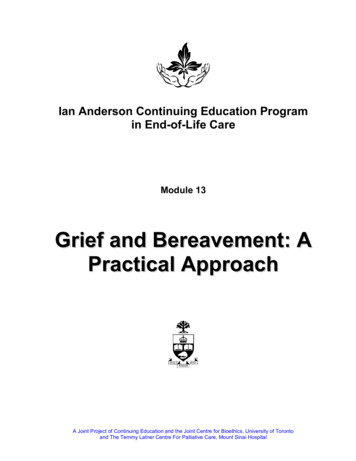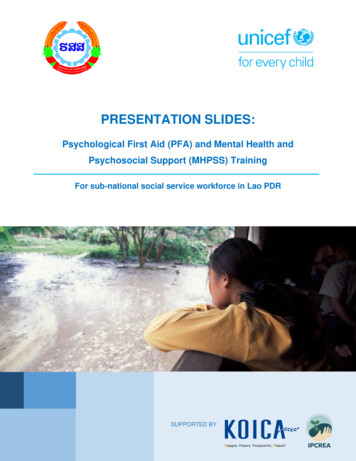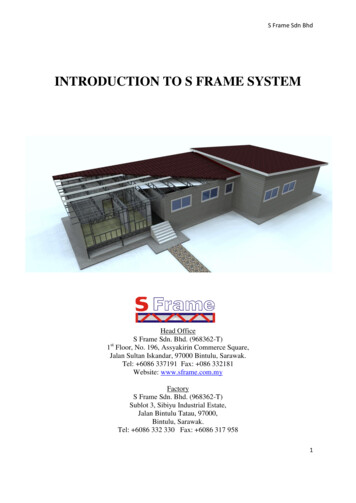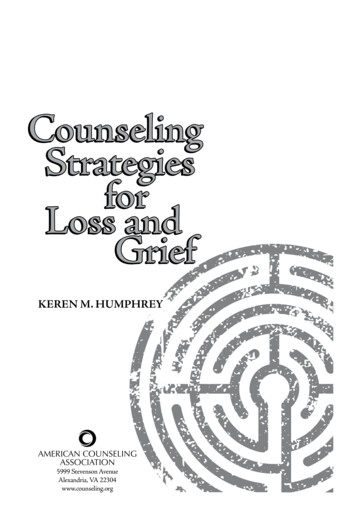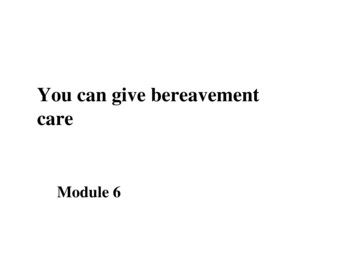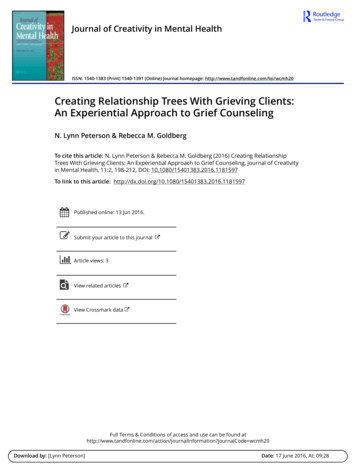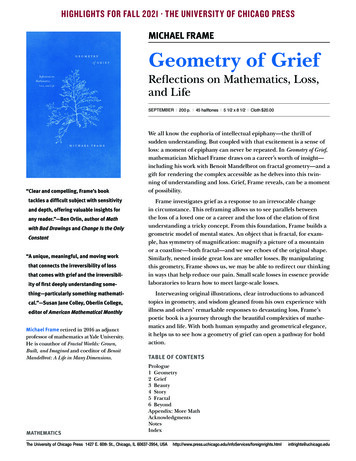
Transcription
HIGHLIGHTS FOR FALL 2021 · THE UNIVERSITY OF CHICAGO PRESSMICHAEL FRAMEGeometry of GriefReflections on Mathematics, Loss,and LifeSEPTEMBER 200 p. 45 halftones 5 1/2 x 8 1/2 Cloth 20.00“Clear and compelling, Frame’s booktackles a difficult subject with sensitivityand depth, offering valuable insights forany reader.”—Ben Orlin, author of Mathwith Bad Drawings and Change Is the OnlyConstant“A unique, meaningful, and moving workthat connects the irreversibility of lossthat comes with grief and the irreversibility of first deeply understanding something—particularly something mathematical.”—Susan Jane Colley, Oberlin College,editor of American Mathematical MonthlyMichael Frame retired in 2016 as adjunctprofessor of mathematics at Yale University.He is coauthor of Fractal Worlds: Grown,Built, and Imagined and coeditor of BenoitMandelbrot: A Life in Many Dimensions.MATHEMATICSWe all know the euphoria of intellectual epiphany—the thrill ofsudden understanding. But coupled with that excitement is a sense ofloss: a moment of epiphany can never be repeated. In Geometry of Grief,mathematician Michael Frame draws on a career’s worth of insight—including his work with Benoit Mandelbrot on fractal geometry—and agift for rendering the complex accessible as he delves into this twinning of understanding and loss. Grief, Frame reveals, can be a momentof possibility.Frame investigates grief as a response to an irrevocable changein circumstance. This reframing allows us to see parallels betweenthe loss of a loved one or a career and the loss of the elation of firstunderstanding a tricky concept. From this foundation, Frame builds ageometric model of mental states. An object that is fractal, for example, has symmetry of magnification: magnify a picture of a mountainor a coastline—both fractal—and we see echoes of the original shape.Similarly, nested inside great loss are smaller losses. By manipulatingthis geometry, Frame shows us, we may be able to redirect our thinkingin ways that help reduce our pain. Small‐scale losses in essence providelaboratories to learn how to meet large-scale losses.Interweaving original illustrations, clear introductions to advancedtopics in geometry, and wisdom gleaned from his own experience withillness and others’ remarkable responses to devastating loss, Frame’spoetic book is a journey through the beautiful complexities of mathematics and life. With both human sympathy and geometrical elegance,it helps us to see how a geometry of grief can open a pathway for boldaction.TABLE OF CONTENTSPrologue1 Geometry2 Grief3 Beauty4 Story5 Fractal6 BeyondAppendix: More MathAcknowledgmentsNotesIndexThe University of Chicago Press 1427 E. 60th St., Chicago, IL 60637-2954, ignrights.htmlintlrights@uchicago.edu
HIGHLIGHTS FOR FALL 2021 · THE UNIVERSITY OF CHICAGO PRESSDAVID NIRENBERG and RICARDO L. NIRENBERGUncountableA Philosophical History of Numberand Humanity from Antiquity tothe PresentSEPTEMBER 432 p. 1 halftone 6 x 9 Cloth 30.00“Ricardo and David Nirenberg, father andson scholars of mathematics and history,have teamed up in a breathtaking voyageexamining the foundations and limits ofknowledge in western thought. It is asource of inspiration and comfort to learnhow the far-flung ideas about numbers,our existence, and the world we live inhave been debated in the past.”—JoachimFrank, Columbia University, Nobel Prize inChemistryDavid Nirenberg is dean of the DivinitySchool at the University of Chicago,where he also teaches in the Committeeof Social Thought and the Department ofHistory. His books include Anti-Judaism:The Western Tradition; Neighboring Faiths:Islam, Christianity, and Judaism in the MiddleAges and Today; and Communities of Violence: Persecution of Minorities in the MiddleAges. After doing research in mathematicsfor a dozen years, David’s father, RicardoL. Nirenberg, turned to his other calling:philosophy and literature. He has published numerous essays, short fiction, andthe novels Cry Uncle and Wave Mechanics: aLove Story. He is the founder and editor ofthe literary journal offcourse.org.HISTORYFrom the time of Pythagoras, we have been tempted to treat numbersas the ultimate or only truth. This book tells the history of that habit ofthought. But more, it argues that the logic of counting sacrifices muchof what makes us human, and that we have a responsibility to matchthe objects of our attention to the forms of knowledge that do themjustice. Humans have extended the insights and methods of numberand mathematics to more and more aspects of the world, even to theirgods and their religions. Today those powers are greater than ever, ascomputation is applied to virtually every aspect of human activity. Butthe rules of mathematics do not strictly apply to many things—from elementary particles to people—in the world. By subjecting such thingsto the laws of logic and mathematics, we gain some kinds of knowledge, but we also lose others. How do our choices about what parts ofthe world to subject to the logics of mathematics affect how we live andhow we die? This question is rarely asked, but it is urgent, because thesciences built upon those laws now govern so much of our knowledge,from physics to psychology. Uncountable sets out to ask it. In chaptersproceeding chronologically from Ancient Greek philosophy and therise of monotheistic religions to the emergence of modern physics andeconomics, the book traces how ideals, practices, and habits of thoughtformed over millennia have turned number into the foundation-stoneof human claims to knowledge and certainty. But the book is also aphilosophical and poetic exhortation to take responsibility for thathistory, for the knowledge it has produced, and for the many aspects ofthe world and of humanity that it ignores or endangers. To understandwhat can be counted and what can’t is to embrace the ethics of purposeful knowing.TABLE OF CONTENTSIntroduction: Playing with Pebbles1 World War Crisis2 The Greeks: A Protohistory of Theory3 Plato, Aristotle, and the Future ofWestern Thought4 Monotheism’s Math Problem5 From Descartes to Kant: AnOutrageously Succinct History ofPhilosophy6 What Numbers Need: Or, When Does2 2 4?The University of Chicago Press 1427 E. 60th St., Chicago, IL 60637-2954, USA7 Physics (and Poetry): Willing Samenessand Difference8 Axioms of Desire: Economics and theSocial Sciences9 Killing Time10 Ethical ConclusionsAcknowledgmentsNotesBibliographyIndex of reignrights.htmlintlrights@uchicago.edu
HIGHLIGHTS FOR FALL 2021 · THE UNIVERSITY OF CHICAGO PRESSCHRIS PEARSONDogopolisHow Dogs and Humans MadeModern New York, London, andParisAUGUST 248 p. 21 halftones 6 x 9 Cloth 95.00 Paper 24.00Animal Lives“Dogopolis is a beautifully presented bookwith an evocative historical voice andgreat confidence and flair. It is also a lotof fun to read. Pearson offers a treasuretrove of details about the shared lives ofhumans and dogs across three rapidlyurbanizing cities that epitomized urbanmodernity, and deals with themes at theheart of urban history in his examinationof the public and private spaces; class,gender, and race relationships; and publichealth and disease.”—Neil Pemberton,Manchester UniversityChris Pearson is a senior lecturer in twentieth-century history at the University ofLiverpool.Stroll through any American or European city today and you probablywon’t get far before seeing a dog being taken for a walk. It’s expected thatthese domesticated animals can easily navigate sidewalks, streets, and otherfoundational elements of our built environment. But what if our citieswere actually shaped in response to dogs more than we ever realized?Chris Pearson’s Dogopolis boldly and convincingly asserts that human-canine relations were a crucial factor in the formation of modernurban living. Focusing on New York, London, and Paris from the earlynineteenth century into the 1930s, Pearson shows that human reactions to dogs significantly remolded them and other contemporaryWestern cities. It’s an unalterable fact that dogs—often filthy, bellicose,and sometimes off-putting—run away, spread rabies, defecate, andbreed wherever they like, so as dogs became more and more commonin nineteenth-century middle-class life, cities had to respond to people’s fear of them and revulsion at their least desirable traits. The gradual integration of dogs into city life centered on disgust at dirt, fear ofcrime and vagrancy, and the promotion of humanitarian sentiments.On the other hand, dogs are some people’s most beloved animal companions, and human compassion and affection for pets and strays wereequally powerful forces in shaping urban modernity. Dogopolis detailsthe complex interrelations among emotions, sentiment, and the wayswe manifest our feelings toward what we love—showing that togetherthey can actually reshape society.TABLE OF CONTENTSIntroductionAcknowledgments1 Straying2 BitingAppendix: Reflections on Animals,History, and Emotions3 SufferingChronology4 ThinkingNotes5 DefecatingIndexCodaHISTORYThe University of Chicago Press 1427 E. 60th St., Chicago, IL 60637-2954, ignrights.htmlintlrights@uchicago.edu
HIGHLIGHTS FOR FALL 2021 · THE UNIVERSITY OF CHICAGO PRESSALEKSANDRA PRICADecay and AfterlifeForm, Time, and the Textuality ofRuins, 1100 to 1900DECEMBER 304 p. 8 halftones 6 x 9 Cloth 105.00 Paper 35.00Aleksandra Prica is assistant professor ofGerman literature at the University ofNorth Carolina at Chapel Hill.Western ruins have long been understood as objects riddled withtemporal contradictions, whether they appear in Baroque poetry anddrama, Romanticism’s nostalgic view of history, eighteenth-centurypaintings of classical subjects, or even recent photographic historiesof the ruins of post-industrial Detroit. Decay and Afterlife pivots awayfrom our immediate, visual fascination with ruins, and instead focuseson the textuality of ruins in works about disintegration and survival.Combining an impressive array of literary, philosophical, and historiographical works both canonical and neglected, and encompassingLatin, Italian, French, German, and English sources, Aleksandra Pricaaddresses ruins as textual forms, examining them in their extraordinary geographical and temporal breadth, highlighting their variabilityand reflexivity, and uncovering new lines of aesthetic and intellectualaffinity. Through theoretically rich close readings, she traverses thelongue durée of 800 years of intellectual and literary history, fromSeneca and Petrarch to Hegel, Goethe, and Georg Simmel. She tracksEurope’s ruins discourses as they metamorphose over time, identifying unremarked resemblances and resonances, ignored contrasts andtensions, as well as the shared apprehensions and ideas these thinkersbring to light. Throughout, she asks, “What persists in keeping theruins of a once grand past alive?”TABLE OF CONTENTSHISTORYList of FiguresList of AbbreviationsIntroductionI Foundations1 Among Ruins: Martin Heideggerand Sigmund Freud2 Afterlife: Hans Blumenberg andWalter BenjaminII The Propitious Moment3 Petrarch and the View of Rome4 Poliphilo and the Dream of RuinsIV The Battleground of Time7 Johann Jacob Breitinger, AndreasGryphius, and the Reconsiderationof Allegory8 Thomas Burnet, GeorgWilhelm Friedrich Hegel, and theRealignment of DiscoursesIII Living On5 Ferdinand Gregorovius, Hildebertof Lavardin, and the Rupture ofContinuity6 Lucius Annaeus Seneca, MartinOpitz, and the Overcoming of VanityEpilogueThe University of Chicago Press 1427 E. 60th St., Chicago, IL 60637-2954, USAV Futures and Ruins9 Johann Wolfgang von Goethe,Georg Simmel, and the Provisionalityof tlrights@uchicago.edu
HIGHLIGHTS FOR FALL 2021 · THE UNIVERSITY OF CHICAGO PRESSJAMES I. PORTERHomerThe Very IdeaSEPTEMBER 280 p. 14 halftones 5 1/2 x 8 1/2 Cloth 27.50 Paper 5.00Homer, the great poet of the Iliad and the Odyssey, is revered as a cultural icon of antiquity and a figure of lasting influence. But his identityis shrouded in questions about who he was, when he lived, and whetherhe was an actual person, a myth, or merely a shared idea. Rather thanattempting to solve the mystery of this character, James I. Porter explores the sources of Homer’s mystique and their impact since the firstrecorded mentions of Homer in ancient Greece.“Porter is an exceptional scholar. Clear,intelligent, and filled with fascinating examples, this book is contemporary whilereaching beyond the fashionable, and itwill arouse a good deal of discussion.”—Simon Goldhill, author of PreposterousPoeticsHomer: The Very Idea considers Homer not as a man, but as a culturalinvention nearly as distinctive and important as the poems attributedto him, following the cultural history of an idea and of the obsessionthat is reborn every time Homer is imagined. Offering novel readingsof texts and objects, the book follows the very idea of Homer from hisearliest mentions to his most recent imaginings in literature, criticism,philosophy, visual art, and classical archaeology.TABLE OF CONTENTSNote on Translations and AbbreviationsJames I. Porter is the Irving Stone Professor of Literature at the University ofCalifornia, Berkeley. He is the author ofnumerous books, including Nietzsche andthe Philology of the Future, The Invention ofDionysus: An Essay on ‘The Birth of Tragedy’,and The Sublime in Antiquity. He has alsoedited several books and is a coauthorof Postclassicisms, also published by theUniversity of Chicago Press.List of IllustrationsTimeline1. Why Homer?2. Who Was Homer?3. Apotheosis or Apostasy?4. What Did Homer See?5. Why War?AcknowledgmentsNotesFurther ReadingWorks CitedIndexLITERARY CRITICISMThe University of Chicago Press 1427 E. 60th St., Chicago, IL 60637-2954, ignrights.htmlintlrights@uchicago.edu
HIGHLIGHTS FOR FALL 2021 · THE UNIVERSITY OF CHICAGO PRESSKARLA MALLETTELives of the GreatLanguagesArabic and Latin in the MedievalMediterraneanSEPTEMBER 264 p. 6 x 9 Cloth 105.00 Paper 35.00“Lives of the Great Languages is a keenlyoriginal and challenging intervention inthe discussion of the life and death of languages. Anyone interested in the historyof Arabic language and culture will findit informative and insightful. It is whatwe need in order to rethink the nationaland monolingual frame through which wediscuss languages, literary traditions,and cultural expressions.”—Wen-chinOuyang, University of LondonKarla Mallette is professor of Mediterranean studies in the Department of MiddleEast Studies and professor of Italian inthe Department of Romance Languagesand Literatures at the University ofMichigan. She is the author of EuropeanModernity and the Arab Mediterranean andThe Kingdom of Sicily, 1100-1250: A LiteraryHistory.In this ambitious book, Karla Mallette studies the nature and behaviorsof the medieval cosmopolitan languages of learning—classical Arabicand medieval Latin—as they crossed the Mediterranean. Through anecdotes of relationships among writers, compilers, translators, commentators, and copyists, Mallette tells a complex story about the transmission of knowledge in the period before the emergence of a nationallanguage system in the late Middle Ages and early modernity.Mallette shows how the elite languages of learning and culture wereonly tenuously related to the languages of everyday life. These languages took years of study to master, marking the passage from intellectualchildhood to maturity. In a coda to the book, Mallette speculates onthe afterlife of cosmopolitan languages in the twenty-first century, theperils of monolingualism, and the ethics of language choice. The bookoffers insight for anyone interested in rethinking linguistic and literary tradition, the transmission of ideas, and cultural expression in anincreasingly multilingual world.TABLE OF CONTENTSPart I: Group Portrait with LanguageChapter 1: A Poetics of the CosmopolitanLanguageChapter 2: My TongueChapter 3: A Cat May Look at a KingPart II: Space, Place, and theCosmopolitan LanguageChapter 4: Territory / Frontiers / RoutesChapter 5: TracksChapter 6: Tribal RugsPart III: Translation and TimePart IV: Beyond the CosmopolitanLanguageChapter 11: SilenceChapter 12: The Shadow of LatinityChapter 13: Life r 7: The Soul of a New LanguageChapter 8: On First Looking into Mattā’sAristotleChapter 9: “I Became a Fable”Chapter 10: A Spy in the House ofLanguageHISTORYThe University of Chicago Press 1427 E. 60th St., Chicago, IL 60637-2954, ignrights.htmlintlrights@uchicago.edu
HIGHLIGHTS FOR FALL 2021 · THE UNIVERSITY OF CHICAGO PRESSHELENA DE BRESArtful TruthsThe Philosophy of MemoirSEPTEMBER 248 p. 5 1/2 x 8 1/2 Cloth 95.00 Paper 22.50“Artful Truths is wonderful, beautifullywritten, consistently amusing, and veryuseful. De Bres unpacks all the philosophical and ethical questions imaginable surrounding the genre of memoirand charges fearlessly into accusationsagainst the form, examining and dissecting each doubt before celebrating thegenre with panache.”—Phillip Lopate,author of The Art of the Personal EssayHelena de Bres is associate professor ofphilosophy at Wellesley College. Herpersonal essays, public philosophy, andhumor writing have appeared in The Point,New York Times, Rumpus, Aeon Magazine,and McSweeney’s Internet Tendency, andshe’s currently writing a memoir about thenature and value of philosophy. Presents an engaging, accessible philosophical tour of the memoir Contains many compelling examples drawn from literature Will appeal broadly to lovers of fiction and nonfictionArtful Truths offers a concise guide to the fundamental philosophicalquestions that arise when writing a literary work about your own life.Bringing a philosopher’s perspective to a general audience, Helena deBres addresses what a memoir is, how the genre relates to fiction, memoirists’ responsibilities to their readers and subjects, and the questionof why to write a memoir at all. Along the way, she delves into a widerange of philosophical issues, including the nature of the self, the limits of knowledge, the idea of truth, the obligations of friendship, therelationship between morality and art, and the question of what makesa life meaningful.Written in a clear and conversational style, it offers a resource forthose who write, teach, and study memoirs, as well as those who loveto read them. With a combination of literary and philosophical knowledge, de Bres takes the many challenges directed at memoirists seriously, while ultimately standing in defense of a genre that, for all itsperplexities—and maybe partly because of them—continually provesto be both beloved and valuable.TABLE OF CONTENTSOne What Is Memoir?Two Is All Memoir Really Fiction?Three Should Memoirists Aim to Tell the Truth?Four What Do Memoirists Owe the People They Write About?Five Why Write a OPHYThe University of Chicago Press 1427 E. 60th St., Chicago, IL 60637-2954, ignrights.htmlintlrights@uchicago.edu
HIGHLIGHTS FOR FALL 2021 · THE UNIVERSITY OF CHICAGO PRESSWILLIAM GERMANOOn RevisionThe Only Writing That CountsOCTOBER 208 p. 1 halftone, 6 line drawings 5 1/2 x 8 1/2 Cloth 45.00 Paper 20.00Chicago Guides to Writing, Editing, and PublishingRevision is a kind of writing, argues William Germano, indeed theonly writing that ultimately counts. That’s because only revision makesa piece of writing worth the time and attention of readers. With thewit and wisdom that distinguished his now classic guides Getting ItPublished and From Dissertation to Book, Germano explains how to getyour writing up to the level where it matters not just to yourself but toothers.William Germano is the author of severalbooks, including Getting It Published: AGuide for Scholars and Anyone Else Seriousabout Serious Books and From Dissertation toBook, both also published by the University of Chicago Press. His most recent book,co-written with Kit Nicholls, is Syllabus:The Remarkable, Unremarkable DocumentThat Changes Everything. He has servedas editor-in-chief at Columbia UniversityPress, vice president and publishing director at Routledge, and dean of the facultyof humanities and social sciences at theCooper Union for the Advancement ofScience and Art, where he is now professor of English literature.On Revision goes far beyond the usual advice to cut for concision,discussing revision as expansion, structural revision across the largerspan of a work, revision as response to one’s audience, and revision asrethinking. Although full of practical advice, this book is no mere howto, and to approach it only as a guide wouldn’t do it justice. It is also alearned, deeply thoughtful essay on what impels revising, and on thewriter’s task.TABLE OF CONTENTS1 Press start2 Good to better3 Know what you’ve got4 Look for an argument5 Build an architecture6 Remember the audience7 What writing wantsAcknowledgmentsA very short bibliographyIndexREFERENCEThe University of Chicago Press 1427 E. 60th St., Chicago, IL 60637-2954, ignrights.htmlintlrights@uchicago.edu
HIGHLIGHTS FOR FALL 2021 · THE UNIVERSITY OF CHICAGO PRESSMORITZ ALTENRIEDThe Digital FactoryThe Human Labor of AutomationJANUARY 208 p. 5 1/2 x 8 1/2 Cloth 95.00 Paper 27.50Moritz Altenried is professor at Humboldt-Universität zu Berlin, Germany.In recent years, tech companies such as Google and Facebook haverocked the world as they have seemingly revolutionized the cultureof work. We’ve all heard stories of lounges outfitted with ping pongtables, kitchens with kombucha on tap, and other amenities thatsupposedly foster creative thinking. Nothing could seem further fromearlier workplaces associated with a different revolution in capitalism:factories, in which employees are required to perform highly circumscribed tasks as quickly as possible to meet quotas—for next to nopay. However, as Moritz Altenried shows in The Digital Factory, thesetypes of workplaces are not so far from the Googleplex as we mightthink. While recent accounts of the transformation of labor after thedemise of the factory highlight the creative, communicative, immaterial, or artistic features of contemporary labor, Altenried uncoversthe factory-like conditions in which many new digital workers performtheir jobs. These workers, such as video game testers, social mediacontent moderators, and Amazon fulfillment center workers, performhighly repetitive, unskilled tasks for low and often contingent wages.Altenried combines five years of qualitative research with an analysisof infrastructural technologies to give us a first-hand account of manynew forms of digital labor that drive contemporary capitalism. Heshows that though today’s factories might look and feel different thanthey did 150 years ago, they still follow the same logics and producethe same unequal outcomes.TABLE OF CONTENTSSOCIAL SCIENCEOneWorkers Leaving the Factory: IntroductionTwoThe Global Factory: LogisticsThreeThe Factory of Play: GamingFourThe Distributed Factory: CrowdworkFiveThe Hidden Factory: Social MediaSixThe Platform as Factory: ConclusionSevenThe Contagious Factory: EpilogueAcknowledgmentsNotesBibliographyIndexThe University of Chicago Press 1427 E. 60th St., Chicago, IL 60637-2954, ignrights.htmlintlrights@uchicago.edu
HIGHLIGHTS FOR FALL 2021 · THE UNIVERSITY OF CHICAGO PRESSCLAUDIO E. BENZECRYThe Perfect FitCreative Work in the GlobalShoe IndustryJANUARY 264 p. 57 halftones 6 x 9 Cloth 105.00 Paper 35.00Claudio E. Benzecry is associate professorof communication studies and sociology(by courtesy) at Northwestern University.He is the author of The Opera Fanatic: Ethnography of an Obsession and the coeditorof Social Theory Now, also published by theUniversity of Chicago Press.We know a lot about how clothing and shoes are made cheaply, butvery little about the process when they are made beautifully. In ThePerfect Fit, Claudio E. Benzecry looks at the craft that goes into designing shoes for women in the US market, revealing that this creativeprocess takes place on a global scale. Based on unprecedented behindthe-scenes access, The Perfect Fit offers an ethnographic window intothe day-to-day life of designers, fit models, and technicians as they puttogether samples and prototypes, showing how expert work is a complement to and a necessary condition for factory exploitation.Benzecry looks at the decisions and constraints behind how shoesare designed and developed, from initial inspiration to the mundanework of making sure a size seven stays constant. In doing so, he alsofosters an original understanding of how globalization works from theground up. Drawing on five years of research in New York, China, andBrazil, The Perfect Fit reveals how creative decisions are made, the kindsof expertise involved, and the almost impossible task of keeping theglobal supply chain humming.SOCIAL SCIENCEThe University of Chicago Press 1427 E. 60th St., Chicago, IL 60637-2954, ignrights.htmlintlrights@uchicago.edu
HIGHLIGHTS FOR FALL 2021 · THE UNIVERSITY OF CHICAGO PRESSSARAH S. RICHARDSONThe MaternalImprintThe Contested Science ofMaternal-Fetal EffectsNOVEMBER 376 p. 22 halftones, 2 tables 6 x 9 Cloth 95.00 Paper 26.00Sarah S. Richardson is professor of the history of science and of studies of women,gender, and sexuality at Harvard University. She directs the Harvard GenderSci Laband is the author of Sex Itself: The Search forMale and Female in the Human Genome, alsopublished by the University of ChicagoPress.The idea that a woman may leave a biological trace on her gestatingoffspring has long been a commonplace folk intuition and a matterof scientific intrigue, but the form of that idea—and its staggeringimplications for maternal well-being and reproductive autonomy—haschanged dramatically over time. Beginning with the advent of moderngenetics at the turn of the twentieth century, biomedical scientists dismissed any notion that a mother—except in cases of extreme deprivation or injury—could alter her offspring’s traits. Consensus assertedthat a child’s fate was set by a combination of its genes and post-birthupbringing.Over the last fifty years, however, this consensus was dismantled,and today, research on the intrauterine environment and its effects onthe fetus is emerging as a robust program of study in medicine, publichealth, psychology, evolutionary biology, and genomics. Collectively,these sciences argue that a woman’s experiences, behaviors, and physiology can have life-altering effects on offspring development. Tracinga genealogy of ideas about heredity and maternal-fetal effects, The Maternal Imprint offers a critical analysis of conceptual and ethical issuesprovoked by the striking rise of epigenetics and fetal origins science inpostgenomic biology today.TABLE OF CONTENTS1. Introduction: The Maternal Imprint2. Sex Equality in Heredity3. Prenatal Culture4. Germ Plasm Hygiene5. Maternal Effects6. Race, Birth Weight, and the Biosocial Body7. Fetal Programming8. It’s the Mother!9. Epilogue: Gender and Heredity in the Postgenomic e University of Chicago Press 1427 E. 60th St., Chicago, IL 60637-2954, ignrights.htmlintlrights@uchicago.edu
HIGHLIGHTS FOR FALL 2021 · THE UNIVERSITY OF CHICAGO PRESSGINO C. SEGRÈ and JOHN D. STACKUnearthing Fermi’sGeophysicsDECEMBER 208 p. 44 halftones, 12 tables 5 1/2 x 8 1/2 Cloth 35.00Nobel Prize–winning physicist Enrico Fermi (1901–54) is known forhis work on experimental particle physics, quantum theory, and statistical mechanics; his contributions to the Manhattan Project; and forhis particular ability to condense complicated problems into approximations for understanding and testing theory in a variety of scientificdisciplines.Praise for The Pope of Physics“An assured and informative biography ofthe pioneering nuclear scientist.”—NewYork Times Book Review, Editors’ Choice“Superb. . . . A definitive study of Fermi’slife and work.”—Wall Street Journal“Impressive. . . . Both intelligent andextremely engaging.”—Washington PostUnearthing Fermi’s Geophysics opens a window onto two underrepresented facets of this extraordinary thinker: Fermi’s contributions as ateacher and to the field of geophysics. Drawing on Fermi’s handwrittencalculations and notes, many of which are reproduced here in photographic facsimile, physicists Gino C. Segrè and John D. Stack havereconstructed a coursebook of Fermi’s insights into the physics of arange of geological and atmospheric phenomena. From gravity onEarth to thermodynamics in the atmosphere, the physics of raindrops,the Coriolis effect in hurricanes, tidal physics, earthquakes and seismicwaves, Earth’s magnetism, atmospheric electricity, and much more,Unearthing Fermi’s Geophysics reveals the hidden workings of theworld above, around, and below us—and of the mind of a great scientist who was able to bring those physical workings to light.“Humane, scientifically astute, and beautifully written.”—Physics TodayGino Segrè is professor emeritus in andformer chair of the Department of Physics and Astronomy at the University ofPennsylvania. Most recently he is coauthorwith Bettina Hoerlin of The Pope of Physics:Enrico Fermi and the Birth of the Atomic Age.John Stack is professor emeritus and former associate head for graduate programsin physics at the University of Ill
sudden understanding. But coupled with that excitement is a sense of loss: a moment of epiphany can never be repeated. In Geometry of Grief, mathematician Michael Frame draws on a career's worth of insight— including his work with Benoit Mandelbrot on fractal geometry—and a gift for rendering the complex accessible as he delves into this .
